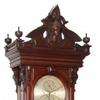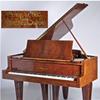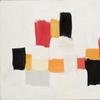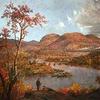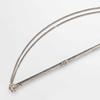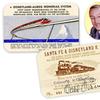Getty Research Institute Acquires Archive of Los Angeles Contemporary Exhibitions (LACE)
- LOS ANGELES, California
- /
- March 15, 2018
The archive covers the first forty years of one of Los Angeles’ central contemporary art institutions – more to come in the future
The Getty Research Institute (GRI) has acquired the archive of Los Angeles Contemporary Exhibitions (LACE), the longest running contemporary artists’ space in Los Angeles. The LACE Records, 1978 to today, covers the first four decades of exhibitions and programs at the institution; future records of the active contemporary art site will be added to the GRI’s collection.
“We are particularly pleased to preserve and study an archive of this caliber from a landmark Los Angeles institution,” said Thomas W. Gaehtgens, director of the Getty Research Institute. “LACE has helped launch careers, supported a vibrant and ever-changing Los Angeles art scene, and pioneered a unique exhibition and performance program that while, artist-driven, supports community development and social causes. Their records connect to many of our holdings and will be invaluable to anyone studying American contemporary art, especially that of Los Angeles.”
The LACE Records paint a dynamic portrait of the organization, from its early days in downtown to more recent years at its current home in Hollywood, as it evolved with the alternative art scene in Southern California. The space served as a crucial site for video, performance, and other art forms, and supported the early work of many artists who have gone on to wider recognition, including ASCO, Mike Kelley, Suzanne Lacy, Paul McCarthy, Rachel Rosenthal, Bruce and Norman Yonemoto, and Rafa Esparza, among others.
Over the course of its existence, LACE has presented the work of more than 5,000 artists in 3,000 programs and events by both Los Angeles-based and visiting artists. LACE was an early champion of video and performance art, with some of the city’s key practitioners serving on its committees, and the space has been noteworthy for its interdisciplinary approach to performance, with significant music and dance programming.
“It would be difficult to exaggerate LACE’s importance in the development of experimental and advanced art in Los Angeles from the late 70s through the mid-90s and their continued role in bringing new, experimental art to the fore,” said Glenn Phillips, curator and head of modern and contemporary art at the GRI. “Because the archive features so many important contemporary artists from Los Angeles and beyond, the material connects to and bolsters the GRI’s already rich holdings of experimental 20th century artists, including feminist performance groups. Additionally, we have significant documentation of the alternative space movement that arose in the US in the 60s and 70s, a movement in which LACE stands out for its longevity and influence.”
LACE began in 1976 in El Monte, when ten artists employed by Los Angeles County decided to open a community access gallery. After a rift with the city over murals, the collective went on to open a gallery space in January 1978 on Broadway in downtown Los Angeles. Because the gallery was in the bridal shop district, the name LACE served as both an acronym and allusion to the neighborhood trade. The thirteen founding artists of LACE were Sarah Parker, who was the first gallery manager; Bill Fisher; Robert Gil de Montes; Harry Gamboa, Jr.; Gronk; Richard Hyland; Joe Janusz; Marlyn Kemppanien; Ron Reeder; Alexander Sauer; Barry Scharf; David Scharf; and Nancy Youdelman. The gallery moved from the bridal district to Industrial Avenue in in downtown Los Angeles in 1986, with support from the Los Angeles Community Redevelopment Agency (CRA).
In 1994 LACE moved to its current location on Hollywood Boulevard in Hollywood. Several founding artists stayed on the board and the institution maintained its approach as an artist-driven organization. Artists who joined the board or served on committees included Mike Kelley, Bruce and Norman Yonemoto, Nancy Buchanan, Jill Giegrich, and many others.
In addition to presenting art and performance, LACE also seeks to advocate for the local community and has staged annual open studio tours for artists, hosted annual exhibitions for neighborhood artists, and worked to unite neighboring communities, including artists, business, and homeless populations. Political advocacy has also been extremely important at LACE throughout its years.
“It is part of our practice as an independent and progressive exhibition space to support investigation and inquiry by artists and scholars and that is why it is so meaningful to us to have our archive at the Getty Research Institute,” said Sarah Russin, Executive Director, LACE. “As we continue to push the boundaries, it’s so encouraging to know that the artists we have championed through the years will be represented at the GRI and that our work will be available for study.”
The LACE Records include photography, ephemera, correspondence from artists, promotional materials, video documentation of events and performance, and other records. The archive will ultimately be cataloged and digitized by the GRI and made available to researchers.
2018 marks the 40th Anniversary of LACE, which is presenting the exhibition The Archival Impulse: 40 Years at LACE, curated by Matias Viegener, with exhibition design by Jeff Cain, opening in LACE’s Project Room in March through the end of the year. This installation pulls from material found in LACE’s archive that either highlights or disputes conceptions of LACE’s history. Accumulated over 40 years, it has no organizing system beyond what LACE staff considered worth saving. It enfolds many stories about the space, less woven than overlaid and amassed. This exhibition is a conversation about expectations of the archive and the things we expect to find, contrasted against the material that does find its way in. This is particularly meaningful in the case of an archive that accumulates rather – than is curated over time – yielding space for a kind of counter-curation. Various events and artist activities will be scheduled throughout the year.
Also, in celebration of its 40th Anniversary, LACE offers a limited edition artwork created in collaboration with iconic LA artist, Barbara Kruger.
More information about LACE events and programs is at www.welcometolace.org


